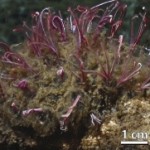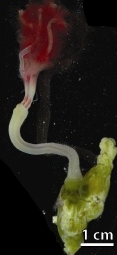
 I tend to avoid the creationist blogs. Every time I get sucked into that vortex of pseudoscience, I find the exact same debunked claims that were bunk when I was 12. There are better bloggers out there who have the energy and patience to systematically dissect the same tired old rubbish day after day, but I’m not one of them.
I tend to avoid the creationist blogs. Every time I get sucked into that vortex of pseudoscience, I find the exact same debunked claims that were bunk when I was 12. There are better bloggers out there who have the energy and patience to systematically dissect the same tired old rubbish day after day, but I’m not one of them.
This claim, however, is special. There’s nothing new in the rhetoric behind it, it’s just another “how could this commensalism/symbiosis/mutualism evolve? It must be magic!” mantra. And the analysis isn’t terribly sophisticated, anyone could do the basic googling to find out why every argument in it is either wrong or deceptive. What’s special is that it’s about one of my favorite critters, Osedax – the bone eating worm.
The author misses the mark from the very beginning. He claims that:
“Bone worms have specialized features that enable them to bore holes through whale bones. Ecologically, they serve to recycle whale bones back into the undersea environment.”


While it is true that Osedax were first discovered on whale carcasses, since then they’ve been found on a host of vertebrate skeletons, including seals, pigs, and cows, and have been hypothesized to occur on dolphins, shark cartilage, and even large fish. Osedax occurrence is not limited exclusively to whales. That fact alone essential makes the rest of the article flawed.
They also don’t recycle entire whale bones back into the ecosystem. Osedax extract certain compounds from the bones and (with the help of autotrophic endosymbionts) convert those compounds into energy. But they leave plenty of material behind, most notably calcium carbonate.
Also, it should go without saying that the “purpose” of Osedax is not to recycle whale bones, the “purpose” is to survive and reproduce another generation of viable individuals and they’ve developed a way to occupy a specific ecologic niche in order to do that.
At this point I should make clear that, while the author seems to be of the impression that there is only one species of Osedax, there are more than 20, each with different life-histories, distributions, and carcass preferences.
The author goes on to make this bizarre claim:
“The very fact that a creature as large as a whale became fossilized in the first place testifies to a uniquely terrible watery disaster in earth’s past. A whale would simply swim away from any of today’s local-level disturbances or tsunamis.”
I guess we never see beached whales, predation, or illness, and whales must be immortal, since they clearly can’t die from old age. In fact, the only thing that could kill a whale is a catastrophic global event. Or maybe he’s arguing that whales wouldn’t be fossilized, since they couldn’t be buried quickly enough? In that case, isn’t he disproving his own point? Whale carcasses on the sea-floor can last for decades, providing a food source to a huge community. Osedax can only colonize the carcass once the bones are exposed. Fossil whale bones colonized by Osedax would never occur in a rapidly buried carcass.
Further, the whale bones examined in the study had not yet been entirely recycled. They were largely intact yet riddled with bore holes. This shows that the bones were preserved before decomposition–a process that takes months, not millions of years–could be completed.
Yet more confusion about what Osedax does. I’ll admit, “bone-eating worm” is a bit of a misleading name. Although the feeding ecology is not completely understood, Osedax do not eat the entire skeleton. They bore into hydrocarbon-rich bones and convert hydrocarbons and collagen into energy. They do not utilize calcium carbonate. So you would absolutely expect to see fossil bones with bore-holes.
So when the author makes the argument that:
The energy associated with inundating a whale is on an order of magnitude consistent with a global flood. And the relative lack of decay during the whale’s fossilization indicates a rapid, not lengthy, time for its burial and preservation.
Is simply inconsistent with reality.
His final statement:
But evolutionary paleontologists ought to also be less happy about this co-occurrence of Osedax with whales, since their presence from the very beginning of the whale’s fossil record is consistent with biblical history. If God created them both on the same day or during the same week, it would stand to reason that there would be no time gap between the origin of whales and the origin of whale-bone-eating Osedax worms.
Is contradicted by his own report that “The PNAS study concluded that Osedax was ‘at least 30 million years old.”‘ The earliest whale fossils date back nearly 65 million years. The seven sources at the bottom of this page go on to provide more details about these amazing animals.
This is a prime example of pseudoscience distorting science under the assumption that readers won’t bother to fact-check their claims.
~Southern Fried Scientist
Jones WJ, Johnson SB, Rouse GW, & Vrijenhoek RC (2008). Marine worms (genus Osedax) colonize cow bones. Proceedings. Biological sciences / The Royal Society, 275 (1633), 387-91 PMID: 18077256
Rouse, G., Wilson, N., Goffredi, S., Johnson, S., Smart, T., Widmer, C., Young, C., & Vrijenhoek, R. (2008). Spawning and development in Osedax boneworms (Siboglinidae, Annelida) Marine Biology, 156 (3), 395-405 DOI: 10.1007/s00227-008-1091-z
Vrijenhoek, R., Collins, P., & Van Dover, C. (2008). Bone-eating marine worms: habitat specialists or generalists? Proceedings of the Royal Society B: Biological Sciences, 275 (1646), 1963-1964 DOI: 10.1098/rspb.2008.0350
Glover AG, Kemp KM, Smith CR, & Dahlgren TG (2008). On the role of bone-eating worms in the degradation of marine vertebrate remains. Proceedings. Biological sciences / The Royal Society, 275 (1646) PMID: 18505721
Haag, A. (2005). Marine biology: Whale fall Nature, 433 (7026), 566-567 DOI: 10.1038/433566a
Goffredi SK, Orphan VJ, Rouse GW, Jahnke L, Embaye T, Turk K, Lee R, & Vrijenhoek RC (2005). Evolutionary innovation: a bone-eating marine symbiosis. Environmental microbiology, 7 (9), 1369-78 PMID: 16104860
Kiel, S., Goedert, J., Kahl, W., & Rouse, G. (2010). Fossil traces of the bone-eating worm Osedax in early Oligocene whale bones Proceedings of the National Academy of Sciences, 107 (19), 8656-8659 DOI: 10.1073/pnas.1002014107
Why would a flood harm a whale in the first place?
I agree with WhySharksMatter. I was reading this at first to find out what was different about this creationist silliness to get you to write about it. I agree with you about the pointlessness of trying to reason with creationists.
Then, I was wondering why anyone, even a creationist, would think that a flood would kill a whale. I was hoping that the Osedax had written Jonah was here in some of the bones.
A God, who created creationists, would have to have a great sense of humor. A comic with an unappreciative, but captive, audience. Maybe a rewrite of Sartre, just leave out the word other.
Ah, the Flood *could* in fact, would kill many sea animals. The dirtying of the water with silts, the dilution of salt water with fresh, the change in temperature, how little photosynthesis would be going on: with all these factors, it seems more strange that the ocean life wasn’t being preserved in the same way as the land animals in the Ark.
Or maybe the Bible just left out Chang’s aquarium, constructed by God’s orders, because he was too smart to leave all the work to one twit.
Although the simpler explanation is none of it happened.
Samantha Vimes,
I am not a biologist, but aren’t most whales are deep water animals, with many species living off of kelp? Neither should be greatly influenced by what happens near land.
Flooding would drive competitors for food into environments they are probably not going to thrive in, not being naturally selected for the deep sea life. Not a lot of whale predators to worry about, but illnesses carried by competitors could be a problem.
Chang’s aquarium? How many cubits per side? 😉
I’m not aware of any kelp-eating whales, but I’m a sharkie by trade. Most whales eat fish/squid/seals or plankton, both of which are pelagic.
Orcas are also known to use nature’s most infamous shark as a tasty, tasty snack
I thought that many whales used baleens to filter kelp out of the ocean. I guess they would consume anything that would be caught in the mouth. I can’t see a whale spitting out some shrimp, claiming that it might have MSG. :-0
It has been a while seen I did any reading on whales.
Orcas have also been known to nibble on the occasional trainer at the water park.
Baleen whales generally eat plankton, not kelp, and they definitely spit out what they don’t want. The baleen works like a filter, but in the opposite direction than most people think. Baleen whales gulp huge amounts of water (containing tasty tasty plankters) and then force the water out of their mouths, through the baleen pleats. They then use their tongues to lick whatever’s left off their pleats.
It seems that I should hold off on writing any papers on whales. 😉
My PhD work is based on the role of Osedax in whale taphonomy and I’ve also seen other occurrences of using whale-falls in creationist literature; always highlighting their scientific ignorance, as illustrated by the assertion that:
“The energy associated with inundating a whale is on an order of magnitude consistent with a global flood”
Clearly they have never herd of turbidity currents or benthic storms! Even under normal slope conditions burial of “Osedaxed” bones is not surprising.